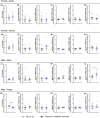Glycerol contained in vaping liquids affects the liver and aspects of energy homeostasis in a sex-dependent manner
- PMID: 35075822
- PMCID: PMC8787618
- DOI: 10.14814/phy2.15146
Glycerol contained in vaping liquids affects the liver and aspects of energy homeostasis in a sex-dependent manner
Abstract
Vaping is increasingly popular among the young and adult population. Vaping liquids contained in electronic cigarettes (e-cigarettes) are mainly composed of propylene glycol and glycerol, to which nicotine and flavors are added. Among several biological processes, glycerol is a metabolic substrate used for lipid synthesis in fed state as well as glucose synthesis in fasting state. We aimed to investigate the effects of glycerol e-cigarette aerosol exposure on the aspects of glycerol and glucose homeostasis. Adult and young male and female mice were exposed to e-cigarette aerosols with glycerol as vaping liquid using an established whole-body exposure system. Mice were exposed acutely (single 2-h exposure) or chronically (2 h/day, 5 days/week for 9 weeks). Circulating glycerol and glucose levels were assessed and glycerol as well as glucose tolerance tests were performed. The liver was also investigated to assess changes in the histology, lipid content, inflammation, and stress markers. Lung functions were also assessed as well as hepatic mRNA expression of genes controlling the circadian rhythm. Acute exposure to glycerol aerosols generated by an e-cigarette increased circulating glycerol levels in female mice. Increased hepatic triglyceride and phosphatidylcholine concentrations were observed in female mice with no increase in circulating alanine aminotransferase or evidence of inflammation, fibrosis, or endoplasmic reticulum stress. Chronic exposure to glycerol e-cigarette aerosols mildly impacted glucose tolerance test in young female and male mice. Fasting glycerol, glucose, and insulin remained unchanged. Increased pulmonary resistance was observed in young male mice. Taken together, this study shows that the glycerol contained in vaping liquids can affect the liver as well as the aspects of glucose and glycerol homeostasis. Additional work is required to translate these observations to humans and determine the biological and potential pathological impacts of these findings.
Keywords: glycerol; liver; vaping.
© 2022 The Authors. Physiological Reports published by Wiley Periodicals LLC on behalf of The Physiological Society and the American Physiological Society.
Conflict of interest statement
The authors have no relevant disclosures or conflict of interest to declare.
Figures






References
-
- Asgharpour, A. , Cazanave, S. C. , Pacana, T. , Seneshaw, M. , Vincent, R. , Banini, B. A. , Kumar, D. P. , Daita, K. , Min, H. K. , Mirshahi, F. , Bedossa, P. , Sun, X. , Hoshida, Y. , Koduru, S. V. , Contaifer, D. Jr , Warncke, U. O. , Wijesinghe, D. S. , & Sanyal, A. J. (2016). A diet‐induced animal model of non‐alcoholic fatty liver disease and hepatocellular cancer. Journal of Hepatology, 65, 579–588. 10.1016/j.jhep.2016.05.005 - DOI - PMC - PubMed
-
- Baba, H. , Zhang, X. J. , & Wolfe, R. R. (1995). Glycerol gluconeogenesis in fasting humans. Nutrition, 11, 149–153. - PubMed
Publication types
MeSH terms
Substances
LinkOut - more resources
Full Text Sources
Medical

